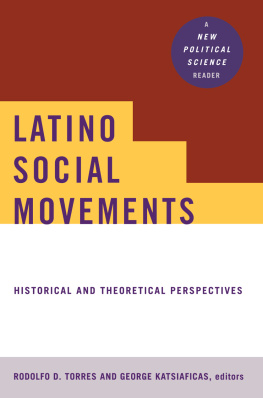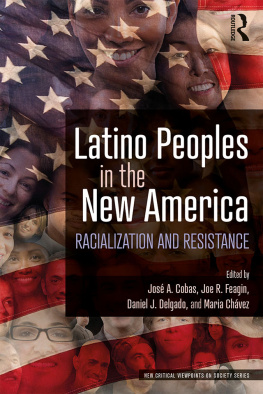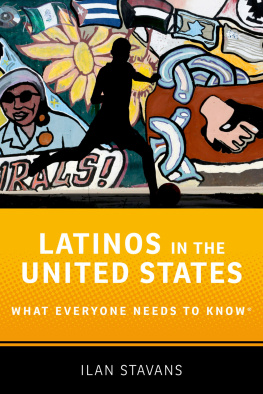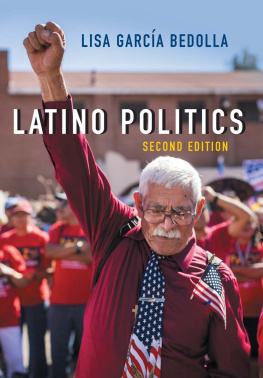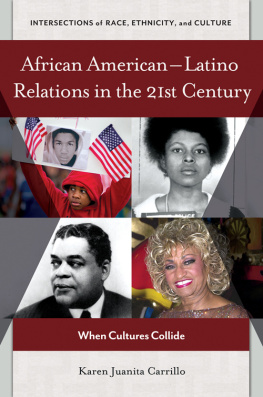Published in 1999 by
Routledge
270 Madison Ave,
New York NY 10016
Published in Great Britain in 1999 by
Routledge
2 Park Square, Milton Park,
Abingdon, Oxon, OX14 4RN
Copyright 1999 by Routledge
Transferred to Digital Printing 2008
All rights reserved. No part of this book may be reprinted or reproduced or utilized in any form or by any electronic, mechanical, or other means, now known or hereafter invented, including photocopying and recording, or in any information storage or retrieval system without permission in writing from the publishers.
Library of Congress Cataloging-in-Publication Data
Latino social movements : historical and theoretical perspectives / a new political science reader
edited by Rodolfo D. Torres and George Katsiaficas.
p. cm.
Includes bibliographical references and index.
ISBN 0415922992 (pbk.)
1. Hispanic AmericansPolitics and government. 2. Hispanic AmericansSocial conditions. 3. Hispanic AmericansEconomic conditions. I. Torres, Rodolfo D., 1949 . II. Katsiaficas, George N., 1949 .
E184.S75L3636 1999
305.868dc21
9833289
CIP
Publishers Note
The publisher has gone to great lengths to ensure the quality of this reprint but points out that some imperfections in the original may be apparent
Rodolfo D. Torres and George Katsiaficas
INTRODUCTION
Over the past several decades, Latinos in the United States have emerged as strategic actors in major processes of social transformation. This new realitythe Latinization of the United Statesis driven by forces that extend well beyond U.S. borders and asserts itself demographically and politically, in the workplace and in daily life.1
W e are pleased to publish this anthology devoted to contemporary Latino politics in the United States. Latinos are an increasingly important segment of the population and have emerged as a major force in the United States, yet this diverse population seldom receives the attention merited by its size or significance. In an earlier publication of some of these articles as a special issue of New Political Science, we noted that the growing Latino presence is closely intertwined with transnational economic forces that are restructuring and reshaping once familiar local, regional, national, and international landscapes. In four decades, global political-economic changes have greatly stimulated Latino immigration to the United States. From a mere 4 million in 1950, accounting for only 2.7 percent of the nations population, Latinos increased more than fivefold to 21.1 million, or 8.5 percent of the total population, in 1990. The Latino population is now growing at the rate of 900,000 persons a year, including net immigration of 350.000. It is estimated that there are now nearly 29 million Latino Americans, or 11 percent of the total U.S. population. According to recent Census Bureau figures, Latinos will supplant African Americans as the nations second largest minority by the year 2005. By the year 2050, it is projected, Latinos will outnumber all other minority groups combined. According to the Census Bureau, California is now 30 percent Latino and could have a Latino majority by the year 2040.
More important than sheer numbers is the fact that Latinos are a significant and growing sector of the United States working class. Within a few years, Latinos will make up more than a quarter of the nations total workforce, a percentage that is more than three times out of proportion to their numbers in the population. Equally important, Latino men and women are increasingly concentrated in the very industries and areas that have been most influenced by the economic restructuring of the United States. Los Angeles County, for example, is the post-industrial heartland of the United States, with industries based on low-paid, nonunionized workers drawn increasingly from the ranks of immigrants, both legal and undocumented. The county is also the nations largest manufacturing center, with 711,000 workers employed in manufacturing. Nearly half of these workers are Latinos. If present employment trends continue, Los Angeless industrial workforce will be almost completely Latinized within several decades.
In spite of Latinos numbers and growing importance, the ongoing Latinization of manufacturing employment over the last several decades has drawn scant notice from scholars, except for some occasional superficial commentaries. The lack of scholarly attention may be attributed to several factors. Perhaps some public policy analysts underestimate the significance of Latino workers because of a tendency to view them as a marginalized sector of the working class. Hence the ubiquitous (and erroneous) perception that the majority of Latina/o workers are employed primarily as farm laborers. Another reason for a lack of attention is the failure of scholars to come to terms with the political and socioeconomic consequences of postindustrial society. Given the strategic space occupied by Latinos in the United States, it is imperative that scholars develop a conceptual language for understanding new forms of racialized relations in a rapidly changing political economy.2 Needless to say, this will require a radical break with the dominant race-relations paradigm, which assigns analytical status to the idea of race and frames racial matters in terms of black and white.3 As noted by Valle and Torres, much needs to be learned about the nature and meaning of Latino class relations in a postindustrial society and the manner in which these divisions manifest themselves in the emerging organization of work, urban politics, and relations with the state.4 This class diversity and different historical experiences within the immigrant population make representing them as a single group highly problematic.
Latino immigrants are connected to their native countries by transnational economic and social processes. The economic conditions faced by Latino communities in the United States are linked to the same international reality shared by populations of Latinos in Latin America and the Caribbean, despite specific regional histories that give rise to particular sociocultural configurations. These configurations are shaped within the context of the ever-changing global economy, the fundamental force that determines migration, production relations, and class positions. The current socioeconomic conditions of Latinos can be directly traced to the relentless expansion of the global economy, most recently exemplified by economic policies such as the North American Free Trade Agreement. NAFTA has weakened the labor participation of Latinos through the transfer of historically well-paying manufacturing jobs to Mexico and other cheap labor manufacturing centers around the world. Such a consequence highlights the need for scholars to link the condition of U.S. Latinos to the global economy.
The study of social, cultural, economic, and political changes in the conditions of Latinos must occur in the context of the particular role that Latinos, as a racialized group, have played in the economic system. As William Robinson noted:
Much sociological writing on Latino groups has focused on demographic phenomena, language, culture, and other descriptive or ascriptive traits. Other studies have stressed emerging ethnic consciousness, pan-Latino political action, and other subjective factors as causal explanations in minority group formation. These factors are all significant. However, in my view, there are broad, historic structural linkages among the distinct groups that constitute the material basis and provide the underlying causal explanation for Latino minority group formation. In other words, cultural and political determinations are relevant, but subsidiary, in that they only become operationalized through structural determinants rooted in the U.S. political economy and in an historic process of capital accumulation into which Latinos share a distinct mode of incorporation.5

